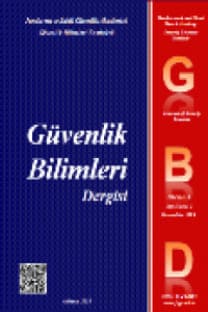REGIONAL CRIME ANALYSIS OF TURKEY: A TIME SERIES APPROACH
Bu çalışmada, Türkiye'nin 7 farklı coğrafi bölgesindeki en yaygın suç türleri zaman serisi yaklaşımı ile analiz edilmiştir. Çalışmanın amacı; her coğrafi bölge için en uygun zaman serisi modelini ortaya koymak ve suç oranları için tahminler yapmaktır. Analizde; 2001-2010 yıllarını kapsayan resmi kaynaklardan elde edilen suç verileri kullanılmıştır. 7 bölge verisinin öncelikli olarak durağanlıkları test edilerek, her bölge için en uygun zaman serisi modeli tespit edilmiştir. Elde edilen zaman serisi modellerinin geçerliliği test edilmiş ve modellerin verdiği sonuçlar 2011 yılı resmi verileriyle karşılaştırılmıştır. Zaman serisi modellerinden elde edilen tahminlerin sonuçlarının önemi ve etkinliği ortaya konulmuştur. Zaman serileri yaklaşımının suçların öngörülebilirliğinde ve güvenlik planlamalarında kullanılabilirliği gösterilmiştir
Anahtar Kelimeler:
Zaman Serileri Analizi, Türkiye’nin Suç Oranları, Suç Önleme, Güvenlik, Öngörü
REGIONAL CRIME ANALYSIS OF TURKEY: A TIME SERIES APPROACH
In this study, the most common types of crime in 7 different geographical regions of Turkey have been analyzed via time-series approach. The purpose of the study is; to put forth the most appropriate time series models for each geographical region and make forecasts for the crime rates. In the analysis; the crime data obtained from official sources covering the years 2001-2010 have been used. The stationarity of 7 regions has been tested and the most appropriate time series model for each region has been determined. The validity of the obtained time series models has been tested and the official data for 2011 have been compared with the forecasts made. As a result, importance and effectiveness of the forecasts obtained from the time series models were given. The availability of the time series approach to crime forecasting was shown for planning security
Keywords:
Time Series Analysis, Turkey’s Crime Rates, Crime Prevention, Security, Forecast,
___
- Akdi, Y.(2010). Zaman Serileri Analizi: Birim Kökler ve Kointegrasyon, Gazi Kitapevi, Ankara.
- Akkuş, Y. (2003). Suçun Ekonomik Analizi: Türkiye Örneği, Atatürk Üniversitesi Sosyal Bilimler Enstitüsü Yüksek Lisans Tezi, Erzurum.
- Andrienko, Y. (2001). Explaining Crime Growth in Russia During Transition: Economic and Criminometric Approach, Centre for Economic and Financial Research, Moscow, February.
- Aslan, A., Öcal, O. (2012). Türkiye’de Suç Oranlarının Devamlılığı, Niğde Üniversitesi, İktisadi ve İdari Bilimler Dergisi, 5(1) 85-92.
- Bal, A.M. (2003). Modern Devlet ve Güvenlik, IQ Kültür Sanat Yayıncılık, İstanbul.
- Beki, C., K. Zeelenberg and N. Fielding. (1999). An Analysis of the Crime Rate in the Netherlands, 1950-1993, British Journal of Criminology, Oxford, 39(3) 401-415.
- Cook, J., Cook, S. (2011). Are US Crime Rates Really Unit Root Processes?, Journal of Quantitative Criminology, 27 299-314.
- Dickey, D. A. and Fuller, W. A. (1979). Distribution of the Estimators for Autoregressive Time Series with a Unit Root, Journal of the American Statistical Association 74.
- Deadman, D. (2000). Forecasting Residential Burglary, Public Sector Economics Research Centre, Department of Economics, University of Leicester, February.
- Göktaş, Ö. (2005). Teorik ve Uygulamalı Zaman Serileri Analizi, Beşir Kitapevi, İstanbul.
- Gujarati, D.N. (2003). Basic Econometrics, McGraw-Hill, New-York.
- İçli, T. (2007). Kriminoloji, Seçkin Yayınevi, 7. Baskı, Ankara.
- Kaygısız, M., Sever, H. (2006). Suç Analizi, Adalet Yayınevi, Ankara.
- Kirchgassner, G. and Wolters, J. (2007). Introduction to Modern Time Series Analysis, New York, Springer.
- Sanlı, S. F. (1998). Türkiye’de Suçların Yapısını Etkileyen Sosyo-Ekonomik Faktörler (Basılmamış yüksek lisans tezi), Ankara, Devlet İstatistik Enstitüsü.
- Sookram, S., Basdeo, M., Sumesar-Rai, K., Saridakis, G. (2010). Serious Crime in Trinidad and Tobago: An Empirical Analysis Using Time- Series Data between 1970-2007,
- Journal of Eastern Caribbean
- Studies, 35(1), March.
- Sutherland, E.H., Cressey, D.R. (1966). Principles of Criminology, J.B. Limpincott Company, New York.
- Williams, F.P., McShane, M.D. (1999). Criminological Theory, USA: Prentice Hall. APPENDIX
- Table A1: Seasonal Unit Root Test Results3.
- In each table, ADF values and their critical values of three models (model without intercept, with intercept,
- with intercept and trend) are given. When ADF value of the model is bigger than the critical value first time,
- it is written in bold.
- Region-1: Mediterranean; Region-2: Eastern Anatolian; Region-3: Aegean; Region-4: Southeastern
- Anatolia; Region-5: Central Anatolia; Region-6: Blacksea and Region-7: Marmara.
- ISSN: 2147-2912
- Yayın Aralığı: Yılda 2 Sayı
- Başlangıç: 2012
- Yayıncı: JANDARMA VE SAHİL GÜVENLİK AKADEMİSİ
Sayıdaki Diğer Makaleler
STRATEJİK İSTİHBARAT ve GENEL YANILGILAR
ASİMETRİK LOJİSTİK FAALİYETLERİN ENGELLENMESİ: DOĞRUSAL PROGRAMLAMA MODELİ UYGULAMASI
Tarık Ziya KOYUNCU, Hakan Soner APLAK, Orhan GERDAN
21’İNCİ YÜZYIL ORTAK GÜVENLİK ORTAMI: ASKERÎ STATÜLÜ KOLLUK KUVVETLERİ İÇİN PLÂNLAMA ÖNERİLERİ
REGIONAL CRIME ANALYSIS OF TURKEY: A TIME SERIES APPROACH
Yunus Emre KARAMANOĞLU, Yılmaz AKDİ
TÜRKİYE’DE DEVRİYE HİZMETLERİ İLE SUÇ İLİŞKİSİNİN İNCELENMESİ: GÖLBAŞI ÖRNEĞİ
